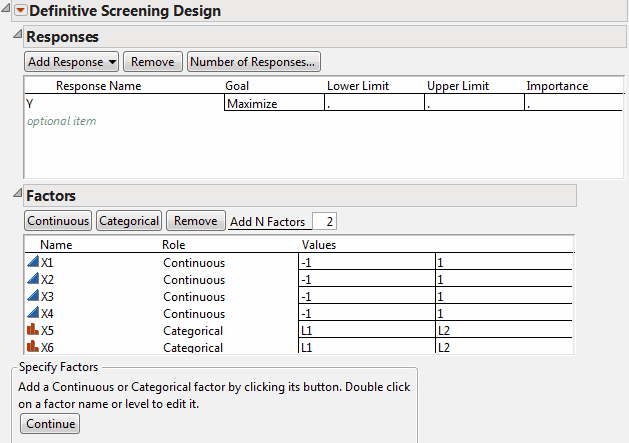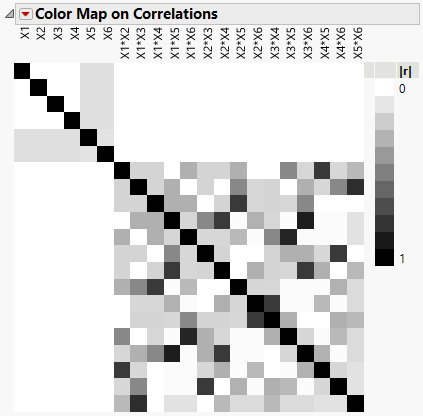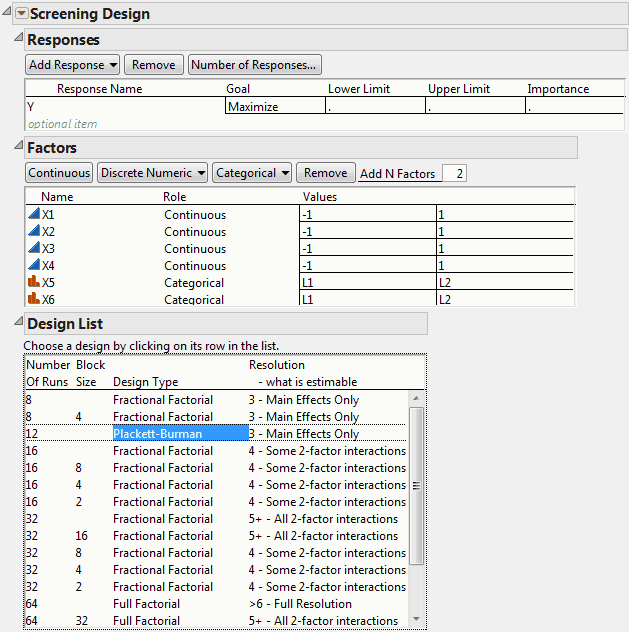Comparison of a Definitive Screening Design with a Plackett-Burman Design
Plackett-Burman designs are an alternative to fractional factorials for screening. However, Plackett-Burman designs have complex aliasing of the main effects by two-factor interactions.
This example shows how to compare a definitive screening with a Plackett-Burman design using the Evaluate Design platform. For an extensive example using the Compare Designs platform, see Designs of Same Run Size in the Compare Designs section.
The Definitive Screening Design
1. Select DOE > Definitive Screening > Definitive Screening Design.
2. Type 4 in the Add N Factors box and click Continuous.
3. Type 2 in the Add N Factors box and click Categorical.
Your window should appear as shown in Figure 7.12.
Figure 7.12 Definitive Screening Dialog with 4 Continuous and 2 Categorical Factors
4. Click Continue.
This example does not require a block. Under the Design Options Outline, check that the No Blocks Required option is selected.
In order to compare designs of approximately equal sizes. do not add Extra Runs.
5. Next to Number of Extra Runs, select 0.
6. Click Make Design.
The design that is generated has 14 runs.
7. Open the Design Evaluation > Color Map On Correlations outline.
Figure 7.13 Color Map for Definitive Screening Design
Notice that the categorical main effects have small correlations with each other and with the continuous factors’ main effects. These correlations lead to a small reduction in the precision of the estimates.
8. Do not close your Definitive Design Screening window until you compare the color map with that of the Plackett-Burman design, below.
The Plackett-Burman Design
Now create a Plackett-Burman design using the same factor structure.
1. Select DOE > Classical > Two Level Screening > Screening Design.
2. Type 4 in the Add N Factors box and click Continuous.
3. Type 2 in the Add N Factors box and click Categorical > 2 Level.
4. Click Continue.
5. Select Choose from a list of fractional factorial designs and click Continue.
Potential designs appear in the Design List.
Figure 7.14 Plackett-Burman Design
6. Select the 12 run Plackett-Burman design (Figure 7.14).
7. Click Continue.
8. Open the Design Evaluation > Color Map On Correlations outline.
Compare the color map for the 12-run Plackett-Burman design to the color map for the 14-run definitive screening design.
Figure 7.15 Plackett-Burman Correlations (left) and Definitive Screening Correlations (right)
Figure 7.15 shows both color maps, but shows only the portion of the Plackett-Burman color map that involves main effects and two-way interactions. (To construct the color map for the Plackett-Burman design without the three-way interactions, construct the design. Then obtain the color map using Evaluate Design.)
In the color map for the Plackett-Burman design on the left, you see that most two-factor interactions are correlated with main effects. This means that any non-negligible two-factor interaction will bias several main effects. This can lead to a failure to identify an active main effect or the false conclusion that an inactive main effect is active.
Contrast this with the color map for the definitive screening design on the right. With only two additional runs, the definitive screening design trades off a small increase in the variance of the main effects for complete independence of main effects and two-factor interactions.



